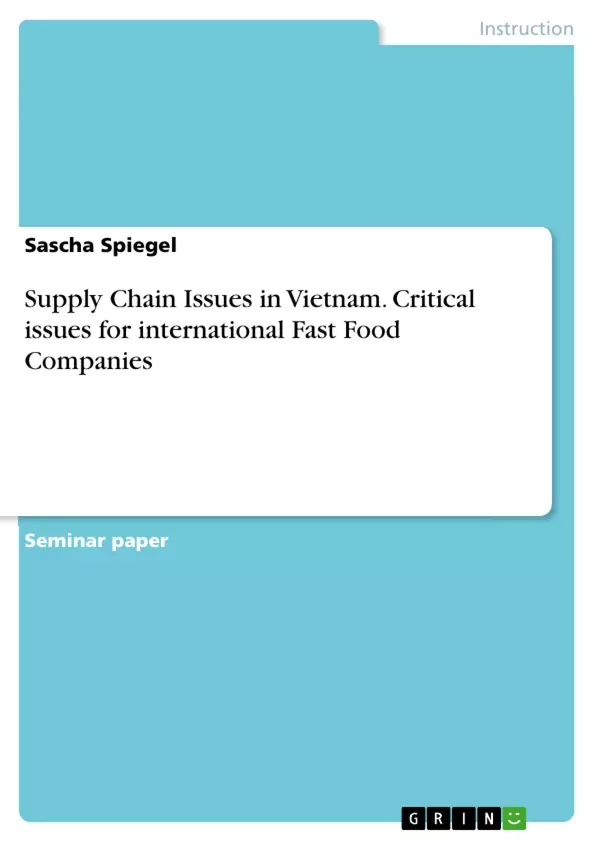The aim of this research is to illuminate issues for both existing and potential franchisors in the areas of franchising and supply chain management in Vietnam. The results of this research not only help international fast food franchises that are already operating in Vietnam to improve the management of their supply chain but also help international fast food franchises by getting a better understanding of the Vietnam market and some of its challenges before starting to operate in Vietnam. The result of this research is a summary of critical issues supply chain issues international fast food franchise companies face when operating in Vietnam. The author also provides a variety of recommendations of how to overcome the identified issues.
Vietnam's hospitality industry is growing all over the country and big international hotel chains like Hyatt Hotels, Sheraton, Hilton, Novotel, Marriott, MGM Grand, Nikko Hotels, Crown Plaza and InterContinental have already entered the country and are operating since the last few years. The famous western style restaurant chains on the other hand are still not that common in Vietnam.
Although Vietnam has a growing economy and young population craving for western food concepts, so far just a few big international fast food franchises have entered Vietnam and most of them are operating for only a few years. The conspicuous absence of some highly successful multinational franchises like McDonald’s begs the question, why are they not operating in Vietnam and why do international fast food franchise companies that are currently operating in Vietnam mainly operate in HCMC and Hanoi?
The research identified that there are several issues international fast food franchise companies need to overcome when operating in Vietnam. Most of the issues are supply chain related and may vary from finding suitable local partners and good retail outlets to having long supply chains with obscure import procedures and high import duties. Moreover, the weak domestic infrastructure such as poorly established railway or road system, substandard port infrastructure or warehouses make storing and shipping within Vietnam a challenge too.
Table of Contents
- Introduction
- Orientation
- Fast Food Franchising
- Supply Chain Management in the Catering Industry
- Vietnam’s Consumer Market
- Franchising in Vietnam
- Local Sourcing
- Importing products to Vietnam
- Vietnam’s Logistics and Transport Infrastructure
- Research methodology
- Data collection methodology
- Data Analysis
- Key Findings
- Sourcing locally
- Challenge of finding local supplier
- Qualifying Local Suppliers
- Transportation Challenges
- Recommendations to reduce the challenges of sourcing locally
- Import based Franchise Systems
- Long and Uncertain Supply Chain
- High Import Duties
- Recommendations to improve the supply chain for import based concepts
- Finding suitable Master Franchisees
- Recommendations to Find Suitable Franchisees
- Finding suitable retail outlets
- Recommendations to reduce Retail Space Challenges
- Sourcing locally
- Key Implications
- Conclusion
Objectives and Key Themes
The research aims to identify and analyze the critical supply chain issues international fast food franchises face when operating in Vietnam. The study will focus on single-point quick service restaurant franchises, such as Lotteria, Burger King, Subway, KFC, Carl’s Jr., and similar quick service restaurants that are operating in Vietnam.
- Supply Chain Management Challenges in a developing country
- Challenges of sourcing local ingredients in Vietnam
- The impact of import-based franchise systems on supply chain management
- Finding and qualifying suitable Master Franchisees in Vietnam
- The difficulties of finding suitable retail outlets in Vietnam
Chapter Summaries
- Introduction: This chapter introduces the research topic, the objectives, and the significance of the study. It highlights the growing presence of international fast food franchises in Vietnam and the challenges they face in establishing their operations.
- Orientation: This chapter provides an overview of franchising, supply chain management, and the Vietnamese market. It discusses the key aspects of fast food franchising, the challenges of supply chain management in the catering industry, the characteristics of Vietnam's consumer market, and the legal framework for franchising in the country.
- Research methodology: This chapter describes the qualitative research approach used in the study, including the data collection methods (secondary and primary data) and data analysis techniques.
- Key Findings: This chapter presents the major findings of the research, highlighting the critical supply chain issues that international fast food franchises face in Vietnam. The chapter examines the challenges of sourcing locally, the impact of import-based systems on supply chain management, the difficulties of finding suitable master franchisees, and the challenges of securing appropriate retail outlets.
Keywords
The research focuses on the key topics of franchising, supply chain management, fast food restaurants, international business, Vietnam, local sourcing, import regulations, logistics, infrastructure, retail space, and master franchisees.
- Arbeit zitieren
- Sascha Spiegel (Autor:in), 2012, Supply Chain Issues in Vietnam. Critical issues for international Fast Food Companies, München, GRIN Verlag, https://www.grin.com/document/335045



